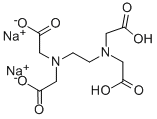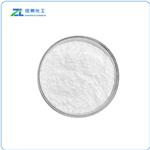Description
Ethylenediaminetetra-acetic acid (abbreviated as EDTA) is used in several industrial applications attributing to its high ability to bind to most of metal cations. EDTA is produced as several salts, e.g. ethylenediaminetetra-acetic acid disodium salt (EDTAS).
EDTA and its salts are used as chelating agents in cosmetic formulations. EDTAS is a preservative, sequestrant, and stabilizer in foods. EDTA is added to ascorbic acid-disodium benzoate containing soft drinks to mitigate the formation of benzene. EDTA and its salts are used as a component in the production of food-contact paper and paperboard. EDTAS is permitted in the feed and drinking water of animals and/or for the treatment of food-producing animals. In the textile industry, EDTA and its salts prevent metal ion impurities from changing colors of dyed products. In the pulp and paper industry, EDTA and its salts inhibit the ability of metal ions from catalyzing the disproportionation of hydrogen peroxide (a typical bleaching agent). EDTAS is used in synthetic rubber manufacture. EDTAS is also used as a corrosion inhibitor to carbon steel in the industries. As an anticoagulant, EDTAS and tripotassium salts of EDTA are most commonly used.
uses
Ethylenediaminetetraacetic acid (EDTA) is an aminopolycarboxylic acid and a hexadentate ligand. It chelates with metal ions, especially with cations to form an octahedral complex. Ethylenediaminetetraacetic acid disodium salt (EDTA) is a blood anticoagulant and contributes to the pathogenesis of pseudothrombocytopenia. It chelates with calcium in the blood and inhibits clotting and is routinely used in haematological tests. It enhances the antibacterial activity of lysozyme. EDTA used in chelation therapy chelates with calcium and favors dilation of artery, solubilisation of atheromatous plaques in atherosclerotic vascular disease. EDTA chelation therapy may also protect from oxidative damage during blood and lipid peroxidation in liver fibrosis.
References
[1] Victor O. Sheffel (2000) Indirect Food Additives and Polymers: Migration and Toxicology.
[2] Lanigan RS, Yamarik TA (2002) Final report on the safety assessment of EDTA, calcium disodium EDTA, diammonium EDTA, dipotassium EDTA, disodium EDTA, TEA-EDTA, tetrasodium EDTA, tripotassium EDTA, trisodium EDTA, HEDTA, and trisodium HEDTA, Int J Toxicol., 21, 95-142
Chemical Properties
Disodium edetate occurs as a white crystalline, odorless powder
with a slightly acidic taste.
Originator
Endrate Disodium,Bersworth,US,1959
Uses
disodium EDTA is a preservative used in concentrations of 0.1 to 0.5 percent.
Uses
Chelating agent (metal); pharmaceutic aid (chelating agent).
Uses
Ethylenediaminetetraacetic acid disodium salt is widely used in textile industry. Usually applied to dissolve limescale. It is applied in textile industry, pulp and paper industry and also in chelation therapy. In cosmetics, it acts as a sequestering agent. It acts as a corrosion inhibitor to carbon steel in the industries. It also acts as a food additive.
Uses
Disodium Dihydrogen EDTA is a sequestrant and chelating agent whose complete name is disodium ethylenediamine tetraacetate. it is a nonhygroscopic powder that is colorless, odorless, and tasteless at recommended use levels. A 1% solution has a ph of 4.3–4.7. It is used to control the reaction of trace metals to include calcium and magnesium with other organic and inorganic components in food to prevent deterioration of color, texture, and development of precipitates and to prevent oxidation. Its function is comparable to that of disodium calcium edta.
Definition
ChEBI: An organic sodium salt that is the anhydrous form of the disodium salt of ethylenediaminetetraacetic acid (EDTA).
Application
Ethylenediaminetetraacetic acid disodium salt dihydrate has been in seed germination trials of plant species and in protein extraction from Moss, Physcomitrella paten. It has also been used in lysis and vacuole buffer for the isolation of vacuoles from Petunia petals.
Chelator of divalent cations. Inhibits enzymes, such as metalloproteases, that require divalent cations for activity.
Production Methods
Disodium edetate may be prepared by the reaction of edetic acid
and sodium hydroxide.
Manufacturing Process
10 mols of ethylene diamine as a 30% aqueous solution and 4 mols of solid
caustic soda are placed in a steam heated kettle supplied with an agitator. 8
mols of sodium cyanide as a concentrated water solution (about 30%) are
added and the solution heated to 60°C. About a 10 inch vacuum is applied to
bring the liquid to incipient boiling. Formaldehyde (7.5 mols of 37% to 40%
aqueous solution) is slowly added, the temperature being held at 60°C, and
the solution vigorously stirred. Then, when the evolution of ammonia has
substantially stopped, an additional 8 mols of sodium cyanide, followed by 8
mols of formaldehyde are added as before. This is continued until 40 mols of
cyanide and 40 mols of formaldehyde have been added. Then at the end
about 2 mols more of formaldehyde are added, making 42 mols in all, to
remove any last traces of cyanide. About 8 to 10 hours are required to
complete the reaction. The resulting product, referred to herein as the crude
reaction product, is essentially an aqueous solution of the sodium salt of
ethylene diamine tetracetic acid.
To 1,000 g of the crude reaction product are added 264 g of ethylene diamine
tetracetic acid. The mixture is preferably heated to incipient boiling to increase
the rate of reaction, and then the mixture is allowed to cool and crystallize.
The crystals formed are filtered off, washed with the smallest possible amount
of ice water, and dried to a constant weight, which is 452 g. A representative
sample of the product so prepared showed, upon analysis, 13.26% sodium
against a theoretical of 13.70% for the disodium salt. The dialkali salt has a
pH of about 5.3 and behaves like a weak acid, displacing CO2 from carbonates
and reacting with metals to form hydrogen. It is a white crystalline solid.
brand name
Endrate (Hospira); Sodium Versenate (3M Pharmaceuticals).
Therapeutic Function
Pharmaceutic aid (chelating agent)
General Description
Ethylenediamine tetraacetate (EDTA) is a calcium ion chelator, that has a low molecular mass of 292.24 Da.
Flammability and Explosibility
Non flammable
reaction suitability
reagent type: chelator
Pharmaceutical Applications
Disodium edetate is used as a chelating agent in a wide range of
pharmaceutical preparations, including mouthwashes, ophthalmic
preparations, and topical preparations, typically at concentrations
between 0.005 and 0.1% w/v.
Disodium edetate forms stable water-soluble complexes (chelates)
with alkaline earth and heavy-metal ions. The chelated form
has few of the properties of the free ion, and for this reason
chelating agents are often described as ‘removing’ ions from
solution, a process known as sequestering. The stability of the
metal–edetate complex is dependent on the metal ion involved and
the pH.
Disodium edetate is also used as a water softener as it will chelate
calcium and magnesium ions present in hard water. It is also used
therapeutically as an anticoagulant as it will chelate calcium and
prevent the coagulation of blood in vitro. Concentrations of 0.1%
w/v are used in small volumes for hematological testing and 0.3%
w/v in transfusions.
Biochem/physiol Actions
Ethylenediaminetetraacetic acid disodium salt has the ability to block the binding of vasoactive intestinal peptide to macrophage membranes. It is mainly used in the purification of protein, to remove divalent cations and also to prevent protease activity.
Safety Profile
Poison by
intraperitoneal and intravenous routes.
Moderately toxic by ingestion. Experimental
teratogenic and reproductive effects.
Mutation data reported. The calcium
disodium salt of EDTA is used as a
chelating agent in treating lead poisoning.
When heated to decomposition it emits
toxic fumes of NOx and NasO.
Safety
Disodium edetate is used widely in topical, oral, and parenteral
pharmaceutical formulations; it is used extensively in cosmetic and
food products. Disodium edetate and edetate calcium disodium are
used in a greater number and variety of pharmaceutical formulations
than is edetic acid. Both disodium edetate and edetate calcium
disodium are poorly absorbed from the gastrointestinal tract and
are associated with few adverse effects when used as excipients in
pharmaceutical formulations.
Disodium edetate, trisodium edetate, and edetic acid readily
chelate calcium and can, in large doses, cause calcium depletion
(hypocalcemia) if used over an extended period of time, or if
administered too rapidly by intravenous infusion. If used in
preparations for the mouth, they can also leach calcium from the
teeth. However, edetate calcium disodium does not chelate calcium.
Disodium edetate should be used with caution in patients with
renal impairment, tuberculosis, and impaired cardiac function.
Although disodium edetate is generally considered safe, there
have been reports of disodium edetate toxicity in patients receiving
chelation therapy.
Nasal formulations containing benzalkonium chloride and
disodium edetate, both known to be local irritants, were shown to
produce an inflammatory reaction, and microscopic examination
showed an extended infiltration of the mucosa by eosinophils, and
pronounced atrophy and disorganization of the epithelium,
although these effects were subsequently shown to be reversible.
The WHO has set an estimated acceptable daily intake for
disodium EDTA in foodstuffs of up to 2.5 mg/kg body-weight
LD50 (mouse, IP): 0.26 g/kg
LD50 (mouse, IV): 0.056 g/kg
LD50 (mouse, OP): 2.05 g/kg
LD50 (rabbit, IV): 0.047 g/kg
LD50 (rabbit, OP): 2.3 g/kg
LD50 (rat, OP): 2.0 g/kg
Veterinary Drugs and Treatments
Edetate Disodium (Sodium EDTA) is a chelating agent that is also
used to stop the melting effect of collagenases and proteases on the
cornea. EDTA is useful in halting melting through inhibition of
matrix metalloproteinases, but is not felt to be useful for melting
caused by infectious agents. As the effect of EDTA on metalloproteinases
is reversible, it must be administered several times daily to
be effective.
storage
Edetate salts are more stable than edetic acid (see also Edetic acid).
However, disodium edetate dihydrate loses water of crystallization
when heated to 120°C. Aqueous solutions of disodium edetate may
be sterilized by autoclaving, and should be stored in an alkali-free
container.
Disodium edetate is hygroscopic and is unstable when exposed
to moisture. It should be stored in a well-closed container in a cool,
dry place.
Incompatibilities
Disodium edetate behaves as a weak acid, displacing carbon dioxide
from carbonates and reacting with metals to form hydrogen. It is
incompatible with strong oxidizing agents, strong bases, metal ions,
and metal alloys.
Regulatory Status
GRAS listed. Included in the FDA Inactive Ingredients Database
(inhalations; injections; ophthalmic preparations; oral capsules,
solutions, suspensions, syrups, and tablets; rectal topical, and
vaginal preparations). Included in nonparenteral and parenteral
medicines licensed in the UK. Included in the Canadian List of
Acceptable Non-medicinal Ingredients.






